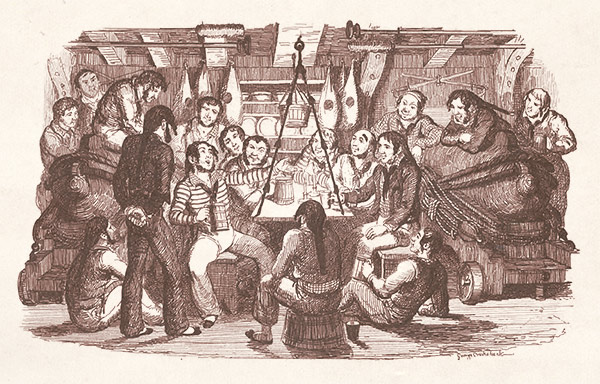Subtotal: $
Checkout
The Plough Music Series is a regular selection of music intended to lift the heart to God. It is not a playlist of background music: each installment focuses on a single piece worth pausing to enjoy.
The Tap Room, the bar at the Griswold Inn in Essex, Connecticut, is older than American independence. Originally constructed in 1735, the Inn has been operating continually as a bar for more than two hundred years. On the Monday evening in July when I visited, four men with microphones and instruments stood at the front of the room; between them and the bar at the back was a tightly packed crowd. Some were sitting at one of the four or five available tables, many were standing – I was told that you’d have to have arrived hours ago to get a table. A Christmas tree also stood between band and bar, lit up with strands of white Christmas lights and decorated with miniature American flags. The walls were plastered with framed old-fashioned drawings of ships.
I never learned the story behind the Christmas tree, but the ships, at least, I understood. Essex is a port town with an important history in the shipbuilding industry. It was this maritime theme that brought me to the Inn. Because every Monday at “the Gris,” you can hear sea shanties.
Or, rather, you can sing them. The band at the front, called the Jovial Crew, leads the shanty session, but the regulars know the music. A woman explained to me that the song lyrics could be found on their website, but you can catch on pretty quickly without looking up the words.
Before the rise of steam-powered craft, throughout the eighteenth and nineteenth centuries, American seamen leavened their work with shanties, call-and-response style songs in order to keep rhythm and boost morale while doing the strenuous physical work of raising sails, working pumps, and hauling up anchors.
Shanties are only one instance of work music. In his book, Work Songs, Ted Gioia discusses the musical traditions of hunters, cultivators, herders, cloth makers, sailors, lumberjacks, cowboys, miners, prisoners, and the workers who made up the labor movement. Most of these old work music traditions are dead, at least as regards their actual use as accompaniments to human labor. As early as 1882, an essay in Harper’s, quoted in Gioia, mourned the death of sea shanties:
The “shanty-man” – the chorister of the old packet ship – has left no successors. In the place of a rousing “pulling song,” we now hear the rattle of the steam-winch; and the modern windlass worked by steam, or the modern steam-pump, gives us the clatter of cogwheels and the hiss of steam in place of the wild choruses of other days. Singing and steam are irreconcilable. The hoarse steam-whistle is the nearest approach to music that can exist in the hot, greasy atmosphere of the steam-engine.
But, at the Griswold Inn, shanties live on. The night I attended they sang “Alabama John Cherokee.” “It’s a halyard chantey,” the Jovial Crew’s website explains, “which is to say it was for the raising of the yard for the setting of the sail; a heavy task in high winds or dirty weather. The pull or ‘heave’ by the crew comes on the down beat of the chorus.” The most famous halyard shanty, according to Gioia, is “Blow the Man Down.” In one version, this song tells the story of a sailor’s confrontation with a policeman: “Policeman, policeman, you do me great wrong, Way, hey, blow the man down, I’m a flying-fish sailor just home from Hong Kong, Way, hey, blow the man down.” (The song leader sings the lines that advance the story solo, with the group coming in on the refrain.)
Music is ubiquitous in our lives. “Art was meshed in with daily living, not set apart for occasional leisure time or for the enjoyment of rich collectors and aesthetes.” This is M. I. Finley on ancient Greece, as quoted by Gioia. Replace “art” with “music” and you have actually described twenty-first century American life – as Gioia recognizes when he refers to the “pervasiveness of music” in contemporary lives.
This extends into the workplace. Today, the phrase “work music” is more likely to bring to mind a playlist than a rhythmic shanty. Search “workday” on Spotify, and the results return playlists such as “workday flow,” “music for a workday,” and “your office stereo.” Reddit contains a subreddit called “r/MusicforConcentration,” with one thread titled “My playlist of high-energy but not distracting electronic music. I disliked how most ‘focus’ playlists were very downtempo. Great for coding. Would love more suggestions for music that fits this style.”
As Work Songs shows, the overlay of music on to work is nothing new, but the shanty tradition is different from today’s lofi hip hop in at least one important respect: traditional work music was sung by all involved in the task, such as the African American work song “Hammer Ring,” which could be used for timber cutting:
Well, God told Norah
Hammer Ring
Well, God told Norah
Hammer Ring
You is a-goin’ in the timber
Hammer Ring
You is a-goin’ in the timber
Hammer Ring.
Listening to music today through AirPods is a passive, individual, consumptive experience; the work song traditions were communal, active, and productive. (That doesn’t mean that these traditions weren’t complicated things. Another essay could be written about how the degrading – or worse – contexts in which these songs arose should nuance any enthusiasm we feel for them as models for us today).

Saturday Night at Sea by George Cruikshank 1841
For Gioia, a key feature of the work song is its call-and-response structure. He connects this to the word vocation, by means of the Latin root:
The call-and-response of the classic work song can serve as a useful metaphor for us even today. ... The concept of the “call” reminds me of the way people once spoke about their work and livelihood. It was a calling, a vocation – from the Latinvocare, to call ... In the modern world what we need most is a model of our interacting lives as a type of call-and-response, rather than as a collection of isolated individuals pursuing separate paths to self-actualization.
In Gioia’s envisioned world, “people’s work would also always be their song, even when no music could be heard.” Perhaps, however, the work song can provide something more concrete. Whatever metaphors you wish to find in it, there is value in the music itself. It is good for human beings to sing together. It builds camaraderie and throws the singers into exercising human creativity. It’s productive and active, rather than merely passive and consumptive.
Gioia relays an image in this regard, drawn from the work of a researcher who studied Native American music. The researcher reportedly found that Native Americans doing carpentry work would sing while working and “sometimes they would even lay aside their tools and become totally absorbed by the music, pushing it ahead to its conclusion with great vigor, forgetful of the task at hand.” It may not seem possible, desirable, or necessary for music to do in offices today what it did for those carpenters or for the sailors singing their shanties. If there is value to communal singing, however, then it’s worth reflecting on how we can make space for it in our lives, whether in or out of the office.
In the meantime, we might look at work music from the other end: music about work, whether sung during work or not. Work music was not always explicitly about the job at hand – sometimes, the lyrics could be nonsense, or vulgar, or dealing with other themes (for instance, eating and drinking) – but sometimes they would deal directly with the work of the singer. How much, however, of the music that office workers listen to every day while sitting at their desks reflects, in an explicit thematic way, on work?
For better or worse, we spend a large proportion of our lives in the workplace and our hours spent there deeply affect our lives. It’s therefore good to develop a habiting of reflecting on it in music, whether in ways that celebrate or ways that critique. Contemporary music that does this does exist. Country musician Jason Isbell’s song “Something More Than Free” is one example. It looks forward to an escatological end of work –
When I get my reward my work will all be done
And I will sit back in my chair beside the father and the son
No more holes to fill and no more rocks to break
And no more loading boxes on the trucks for someone else’s sake.
– while expressing a mix of emotions about the singer’s work on earth in the present. Singer-songwriter Harrison Lemke released this past September “Rundown Lonesome Used Car Lot Blues,” a song “dedicated to every valiant [A]merican soul who has ever been forced to do Drudgery for The Man.” (You can subscribe to Lemke’s Patreon here.) Gillian Welch’s son “Everything Is Free” also fits here:
Everything is free now
That’s what they say
Everything I ever done
Gotta give it away
Someone hit the big score
They figured it out
That we’re gonna do it anyway
Even if doesn’t pay.”
Even if communal singing in your office is out of the question, encouraging and patronizing such music is one way to bring work and music back together.
This playlist contains songs from different traditional work song genres or fields. It starts with sea shanties – the first song, Alabama John Cherookee, was sung at the Gris during my trip there – and moves through cowboy songs, prison worksongs, Scottish waulking songs for cloth working, and Bahrainian pearl diving fidjeri music, among others. It ends with some contemporary songs about work. The list is largely, but not entirely, sourced from the suggested album list at the back of Ted Gioia’s book Work Songs.

Peter Blair serves as the Program Director for the Augustine Collective at the Veritas Forum, helping to support student publications at universities across the country.
Already a subscriber? Sign in
Try 3 months of unlimited access. Start your FREE TRIAL today. Cancel anytime.






